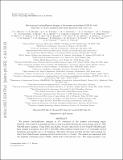Sub-arcsecond (sub)millimeter imaging of the massive protocluster G358.93-0.03 : discovery of 14 new methanol maser lines associated with a hot core
Abstract
We present (sub)millimeter imaging at 0.5'' resolution of the massive star-forming region G358.93-0.03 acquired in multiple epochs at 2 and 3 months following the recent flaring of its 6.7 GHz methanol maser emission. Using SMA and ALMA, we have discovered 14 new Class II methanol maser lines ranging in frequency from 199 GHz to 361 GHz, which originate mostly from vt=1 torsionally-excited transitions and include one vt=2 transition. The latter detection provides the first observational evidence that Class II maser pumping involves levels in the vt=2 state. The masers are associated with the brightest continuum source (MM1), which hosts a line-rich hot core. The masers present a consistent curvilinear spatial velocity pattern that wraps around MM1, suggestive of a coherent physical structure 1200 au in extent. In contrast, the thermal lines exhibit a linear pattern that crosses MM1 but at progressive position angles that appear to be a function of either increasing temperature or decreasing optical depth. The maser spectral profiles evolved significantly over one month, and the intensities dropped by factors of 3.0 to 7.2, with the vt=2 line showing the largest change. A small area of maser emission from only the highest excitation lines closest to MM1 has disappeared. There are seven additional dust continuum sources in the protocluster, including another hot core (MM3). We do not find evidence for a significant change in (sub)millimeter continuum emission from any of the sources during the one month interval, and the total protocluster emission remains comparable to prior single dish measurements.
Citation
Brogan , C L , Hunter , T R , Towner , A P M , McGuire , B A , MacLeod , G C , Gurwell , M A , Cyganowski , C J , Brand , J , Burns , R A , Caratti o Garatti , A , Chen , X , Chibueze , J O , Hirano , N , Hirota , T , Kim , K -T , Kramer , B H , Linz , H , Menten , K M , Remijan , A , Sanna , A , Sobolev , A M , Sridharan , T K , Stecklum , B , Sugiyama , K , Surcis , G , Van der Walt , J , Volvach , A E & Volvach , L N 2019 , ' Sub-arcsecond (sub)millimeter imaging of the massive protocluster G358.93-0.03 : discovery of 14 new methanol maser lines associated with a hot core ' , Astrophysical Journal Letters , vol. 881 , no. 2 , L39 . https://doi.org/10.3847/2041-8213/ab2f8a
Publication
Astrophysical Journal Letters
Status
Peer reviewed
ISSN
2041-8205Type
Journal article
Collections
Items in the St Andrews Research Repository are protected by copyright, with all rights reserved, unless otherwise indicated.

